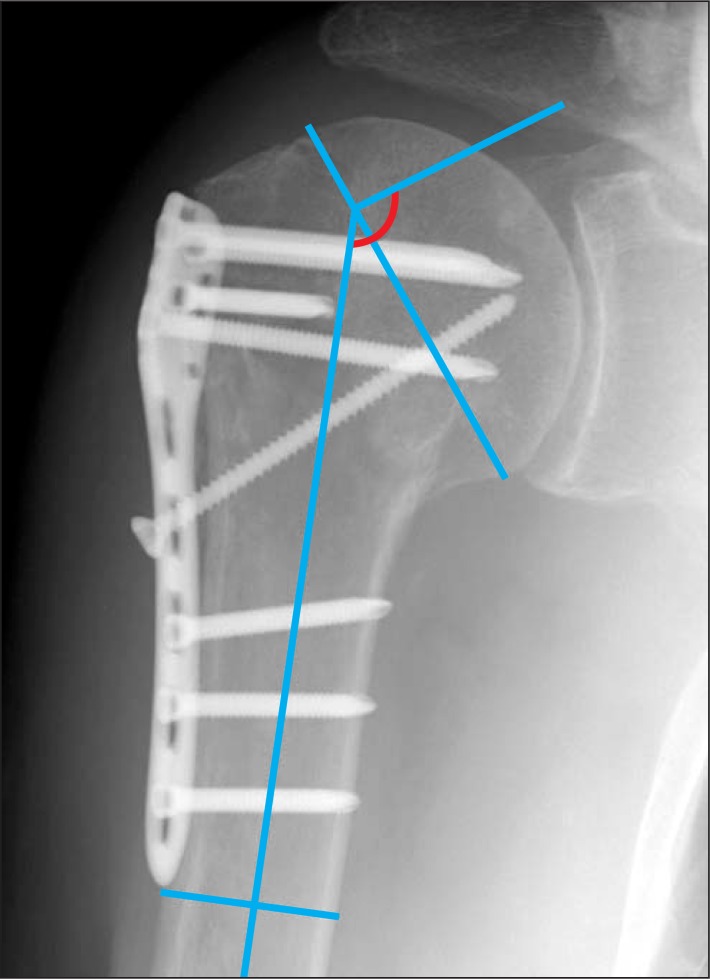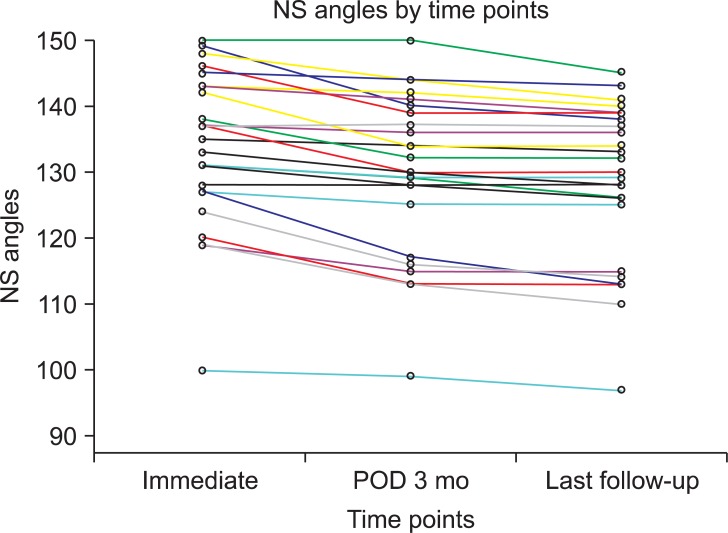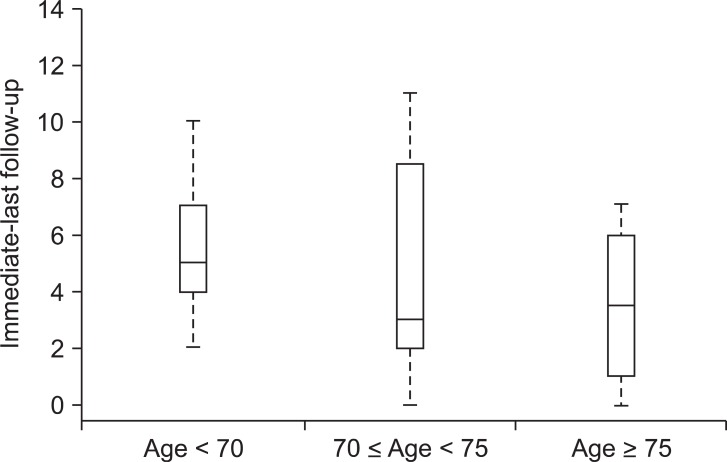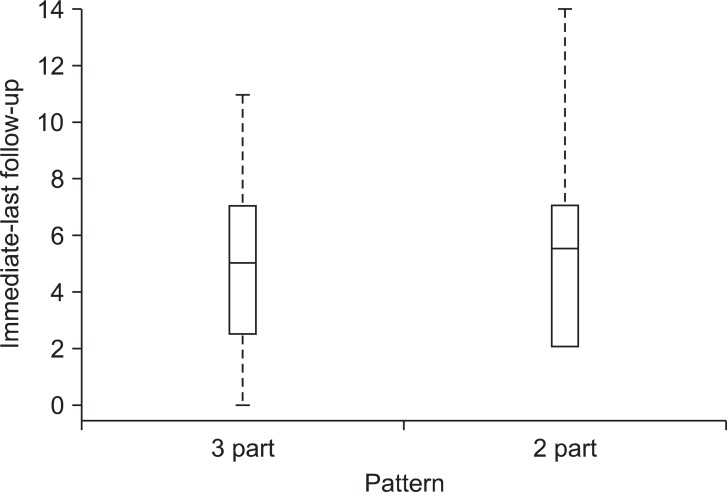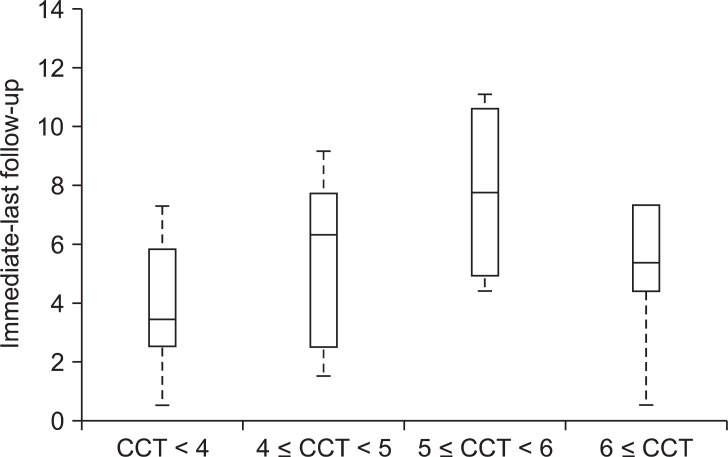Abstract
Background
We conducted this radiographic study in the elderly population with proximal humeral fracture aiming to evaluate 1) the serial changes of neck-shaft angle after locking plate fixation and 2) find relationship between change in neck shaft angle and various factors such as age, fracture pattern, severity of osteoporosis, medial support and initial reduction angle.
Methods
Twenty-five patients who underwent surgical treatment for proximal humeral fracture with locking plate between September 2008 and August 2010 are included. True anteroposterior and axillary lateral radiographs were made postoperatively and at each follow-up visit. Measurement of neck shaft angle was done at immediate postoperative, 3 months postoperative and a final follow-up (average, 11 months; range, 8 to 17 months). Severity of osteoporosis was assessed using cortical thickness suggested by Tingart et al.
Results
The mean neck shaft angles were 133.6° (range, 100° to 116°) at immediate postoperative, 129.8° (range, 99° to 150°) at 3 months postoperative and 128.4° (range, 97° to 145°) at final follow-up. The mean loss in the neck-shaft angle in the first 3 months was 3.8° as compared to 1.3° in the period between 3 months and final follow-up. This was statistically significant (p = 0.002), indicating that most of the fall in neck shaft angle occurs in the first three months after surgery. Relationship between neck shaft angle change and age (p = 0.29), fracture pattern (p = 0.41), cortical thickness (p = 0.21), medial support (p = 0.63) and initial reduction accuracy (p = 0.65) are not statistically significant.
Conclusions
The proximal humerus locking plate maintains reliable radiographic results even in the elderly population with proximal humerus fracture.
Keywords: Proximal humeral fracture, Neck shaft angle, Elderly population, Locking plate
Elderly patients depend on an intact musculoskeletal system in order to maintain function and independence in activities of daily living. Proximal humeral fractures account for around 5% of all fractures and there is an increasing rate in elderly patients.1) There is a lack of agreement on the best treatment of these fractures, particularly in older patients. Traditional internal fixation stabilization methods for proximal humeral fractures include percutaneous K-wiring, screw fixation, tension band wiring and conventional plates and screws, intramedullary nailing.2-4) Surgical treatment either by open reduction and internal fixation or prosthetic replacement in these population has been reported being successful, however, there have been concerns with regard to poor bone quality in geriatric patients.5)
In order to overcome the problems associated with osteoporotic unstable proximal humeral fractures, several implants have been developed during the last decades. One of the most recent developments is the locking compression plate (LCP). The LCP allows controlled fracture compression and has been widely used as angular stability offers several advantages in osteoporotic bone.6)
Several studies have yielded promising clinical results with the LCP.7,8) Although outcomes of the LCP for proximal humeral fracture have been well documented and the knowledge of the LCP is continuously increasing, there are few studies which follow the serial postoperative changes in the neck shaft angle after use of the LCP in the elderly.
We conducted this radiographic study in the elderly population with proximal humeral fractures aiming to evaluate 1) the serial changes of neck-shaft angle after LCP fixation and 2) find the relationship between the change in neck shaft angle and various factors such as age, fracture pattern, severity of osteoporosis, medial support and initial reduction angle.
METHODS
This study was conducted in a tertiary referral hospital. All patients who underwent surgical treatment for a proximal humeral fracture with a locking plate during the study period were collected from the hospital trauma registration and reviewed for the study.
The criteria for inclusion in the present study were a proximal humeral fracture that had been treated surgically up to three weeks after the initial injury. The cut off value of age at the time of surgery was 65 years or older. Between September 2008 and August 2010, 41 patients met the criteria. We excluded patients with isolated fractures of the greater tuberosity or lesser tuberosity, a pathological fracture, patients with polytrauma, and patients who were not able to comprehend the given informed consent reliably. In addition, those patients with four part fracture dislocation who required prosthetic replacement were also excluded. Individuals who were managed non-operatively (as a consequence of being deemed unfit for surgery) were excluded from the analysis. We also excluded patients with incomplete data and lost follow-up. Twenty-five patients were available for the final analysis. Senior authors conducted all the operations during the study period.
Operative Technique
Surgery was performed with the patient in the beach-chair position on a radiolucent table. The standard deltopectoral approach was used. The fracture was exposed and special attention was paid to minimize surgical trauma to the adjacent soft tissue. We did not expose the medial soft tissue hinge in order to reduce the fracture. The reduction was confirmed with the use of image intensification. The LCP was positioned 2 cm posterior to the bicipital groove, with care being taken to ensure that a sufficient gap was maintained between the plate and the long head of the biceps. Medial hinge was considered an important radiographic indicator when assessing initial reduction accuracy. When fracture reduction and subsequent screw positioning was considered adequate, the plate was fixed definitively with the insertion of locking screws into the humeral head. Tension band type sutures were added over the greater tuberosity to provide additional stability.
Postoperatively, the arm was immobilized in a sling and controlled passive mobilization exercise with abduction and flexion beyond 90° was started within three weeks postoperatively, depending on the stability of the osteosynthesis and the bone quality.
Radiographic Evaluation
True anteroposterior and axillary lateral radiographs were made postoperatively and at each follow-up visit. The assessment of radiographs was done at three points in the postoperative period, immediate postoperative, at 3 months postoperative, and a final follow-up (average, 11 months; range, 8 to 17 months). All radiographs were taken by the same two technicians in the same setting as standard protocol in order to minimize potential errors. Also, the radiographs were analyzed by one author. The neck-shaft angle was measured as described by Agudelo et al.9) (Fig. 1). Radiographs were assessed to find the presence of bridging osseous trabeculae, which is suggestive of healing, as well as failure of the fixation. A fracture pattern was determined and confirmed by the senior surgeons based on the Neer classification.10) Severity of osteoporosis in the proximal humerus was assessed using cortical thickness suggested by Tingart et al.11) On the anteroposterior view, we measured the lateral and medial cortical thickness at two different levels and calculated the mean of the four measurements. Level 1 was the most proximal level of the humeral diaphysis and level 2 was 20 mm distal to level 1. The presence or absence of medial support, as described by Gardner et al.12) was assessed. We divided the patients into two groups; those with medial support and those without medial support. On the anteroposterior view, we determined that the fracture has medial support when 1) the medial cortex was intact without comminution, and reduced anatomically, and/or 2) the shaft was impacted into the head fragment, and/or 3) a locking screw was placed in the inferomedial quadrant of the humeral head within 5 mm of the subchondral bone.
Fig. 1.
Measurement of neck shaft angle.
Statistical Analysis
Changes in neck-shaft angle (difference between the immediate postoperative angle and the last follow-up angle) were compared with fracture pattern and presence or absence of medial support using t-test. We also used t-test to see whether the fall in the angle during the first 3 months was higher than the fall in the angle between 3 months and the final follow-up period. We fitted univariate regression for age and combined cortical thickness (CCT) to see if there is any association between the neck-shaft angle changes and continuous variables of age and CCT. In addition, we fitted a linear mixed model to see whether changing pattern over time is statistically significant. The linear mixed model includes additional random-effect terms, so it is often appropriate for clustered data or data gathered over time regarding the same individuals.13) All reported p-values were 2-sided, and p-values < 0.05 were considered statistically significant. A package developed by Pinheiro and Bates13) and R software were used for all statistical analyses.
RESULTS
The average age of the patients was 70 years (range, 65 to 82 years). Twenty-one (84%) patients were women and four (16%) were men. Twenty-two (88%) patients sustained the fracture due to a trivial fall such as falling from a standing position, two were involved in a motor-vehicle accident and one was physically assaulted. There were ten (40%) Neer type 2 fractures and fifteen (60%) Neer type 3 fractures.
All fractures were united within three months of the index operation. Complications included postoperative delirium and superficial stitch abscess in one patient each. There were no deep infections, nerve or vascular injuries, complications related to hardware such as loosening or screw cutout, nonunion or osteonecrosis of the humeral head.
Neck Shaft Angle
The mean neck shaft angles at different points in time are represented in Table 1 and Fig. 2. The mean loss of neck shaft angle between the immediate postoperative and the final follow-up period was 5.6° (range, 0° to 14°) (Fig. 2). The mean loss in the neck-shaft angle in the first 3 months was 3.8° as compared to 1.3° in the period between 3 months and the final follow-up. This was statistically significant (p = 0.002), indicating that most of the decrease in neck shaft angle occurs in the first three months after surgery. Only three patients showed a total loss of reduction of greater than 10°.
Table 1.
Neck Shaft Angle Change in the Serial Radiographs
Fig. 2.
Changes in the neck shaft (NS) angle over various time periods.
We considered an immediate postoperative neck shaft angle of less than 120° to be varus malalignment.9) There were three cases with varus malalignment in our series. The mean fall in the neck shaft angle in these was 5.3°.
Relationship between the Change in Neck Shaft Angle and Various Clinical Factors
Age
There was a trend that with increasing patient age, the fall in neck shaft angle decreased, but this was not statistically significant (p = 0.29) (Fig. 3).
Fig. 3.
Relation between patient age and the change in neck shaft angle (immediate postoperative minus last follow-up).
Fracture pattern
The mean decrease in 2-part fractures was 5.9° and in 3-part fractures it was 4.7°. There was no statistically significant relationship between the change in neck shaft angle and fracture pattern (p = 0.41) (Fig. 4).
Fig. 4.
Relation between fracture pattern and the change in neck shaft angle (immediate postoperative minus last follow-up).
Combined cortical thickness
Mean value of the combined cortical thickness was 4.8 mm (range, 3.4 to 6.8 mm). With regards to univariate regression, as the combined cortical thickness increased the fall in neck shaft angle increased. This, however, was not statistically significant (p = 0.21) (Fig. 5).
Fig. 5.
Relation between the combined cortical thickness (CCT) and the change in neck shaft angle (immediate postoperative minus last follow-up).
Medial support
Based on Gardner's definition, 20 patients were determined as intact medial support and 5 were without medial support. Those with medial support presented a loss in neck shaft angle of 5° at the final follow-up compared to 5.8° in the group without medial support. This was not statistically significant (p = 0.63).
Initial reduction accuracy
We analyzed the relation between initial reduction accuracy and the change in neck-shaft angle by dividing the patients into two groups, those with an initial reduction angle less than 135° and those equal to or more than 135°. The mean loss was greater in the former group (5.5°) compared to that in the latter (4.8°). There was no statistically significant difference between the two groups (p = 0.65).
DISCUSSION
The majority of patients with proximal humeral fractures are above sixty years old, and most of these fractures in this population are related to osteoporosis.14) Nevertheless, stable reduction is essential for healing of the fracture and for achieving early functional recovery of the shoulder. Management of an older patient who has a proximal humeral fracture is challenging because of the hazards posed by the osteopenic bone and the potential for medical complications due to associated comorbidities.
Kristiansen et al.14) reported satisfactory or excellent results in only nine of twenty patients who had fixation of a proximal humeral fracture with a T-buttress plate, and there was a high rate of fixation failure. Fixed angled devices such as the angled blade plate were considered useful as they resisted angular deformation and torsion.15) However, Meier et al.16) did not recommend internal fixation with angled blade plate in unstable proximal humerus fractures due to the high rate of complications (33%) including protrusion of the blade into the glenohumeral joint (22%). Disadvantages of the percutaneous pinning technique include the potential for pin migration, loss of reduction, and pin-site infection. Injury to important anatomic structures concerning the shoulder is also a potential concern with this technique.17) Moreover, fixation using intramedullary nailing has also shown variable results.18,19)
The LCP is a relatively new modality in the armamentarium of the surgeon in tackling this category of fractures.20) Several advantages have been outlined in recent literature. According to Bjorkenheim et al.,8) the main advantage of this plate was apparent in elderly patients, since there were no failures of the internal fixation in this group, and they were able to attain an activity level, which was sufficient to satisfy their needs regarding independent daily living. They are site-specific, low-profile plates. The plate is precontoured for the proximal humerus, and the insertion of locking screws obviates the need for a plate-to-bone compression, preserving the blood supply to the bones.20) The insertion of multiple polyaxial locking screws through the specific targeting device into the fragments of the humeral head provides fixed-angle support in multiple planes, which in theory should maintain the reduction achieved, while allowing for early mobilization.21) The key to this technology is the fixed-angle relationship between the screws and plate. The threaded screw heads are locked into the threaded plate holes in order to prevent screw toggle, slide, and pull-out, thus diminishing the possibility of a primary or secondary loss of reduction.6) The load is transmitted from the bone to the plate via the screw-plate threaded connection. Since the plate and screws form a single stable system, the stability of the fracture depends on the stiffness of the entire construct.6)
The mean age of the patients in our study group was 70 years. Also, 84% of our sample population was women. By the Neer classification, there were 10 two part fractures and 15 three part fractures. The demographic and fracture-related characteristics in our study group were thus comparable to those in previous studies.7,15,16)
We observed two complications in 25 patients during the one-year follow-up. There was one case with a superficial infection, which was effectively treated with antibiotics. This is similar to the 5% superficial infection rate reported by Koukakis et al.22) The other was postoperative delirium from which the patient recovered within 24 hours. While complications such as subacromial impingement, initial malreduction, nonunion, and osteonecrosis have been reported in literature, the overall complication rate in our study was encouraging.2,7) This may be due to our exclusion of Neer type 4 fractures, which have reported a prevalence of 21% to 75% regarding osteonecrosis.23) We did have three cases with initial varus malalignment, but the mean fall in neck shaft angle in these cases (5.3°) matched that of the entire sample (5.6°).
In our series, the mean loss of neck shaft angle was 5.9° in two part fractures and 4.7° in three part fracture patients. This loss occurred maximally within the first three months of surgery. Zhang et al.24) reported an early loss of fixation in the initial 12 weeks after surgery. They reported a mean loss of 1.6° ± 1.3° in patients with medial support and 1.3° ± 1.2° in patients without medial support in two part fractures, and a mean loss of 3.5° ± 2.4° in patients with medial support and 6.1° ± 3.1° in patients without medial support in three part fractures.
We observed that the patient age did not significantly affect the loss in neck shaft angle. Moonot et al.25) demonstrated no significant difference in the functional outcome between patients under and over 65 years old at a mean follow-up of 11 months post PHILOS plate fixation. The LCP may thus provide an acceptable surgical option in proximal humerus fractures irrespective of patient age.
We used the combined cortical thickness as described by Tingart et al.11) as an indicator of bone quality. The combined cortical index did not significantly affect the change in neck shaft angle. Siwach et al.26) concluded in their study that proximal humerus fractures with grade IV osteoporosis by Singh's index did worse as compared to those with grade II osteoporosis. Bjorkenheim et al.8) used an LCP in 72 patients and concluded that this method was safe and recommended its use in treating proximal humerus fractures in elderly patients with poor bone stock. In this study, we found that Tingart's cortical index presented minimal effect on the decrease of neck shaft angle. This is in accordance to a recent biomechanical study on locking plates in the proximal humerus where the authors concluded that the mechanical strength of the plate was unaffected based on a threshold combined proximal humerus cortical thickness of 4 mm.27)
Evaluation of fractures on the basis of medial support as described by Gardner et al.12) revealed that the loss of neck shaft angle was less when there was medial support, although this was not statistically significant. We could not replicate the statistical results obtained by Gardner et al.12) but two part fractures showed a slightly better result than three part fractures. Gardner et al.12) stressed the importance of recreating continuity of the medial column or placement of inferomedial screws in the humeral head. Analysis of the histomorphometry and microstructural architecture of the humeral head bone stock also demonstrates that trabecular thickness and density are the greatest in the medial region.28) Liew et al.29) also found screw purchase to be significantly greater in screws placed into the medial subchondral bone.
Yang et al.30) in a recent study concluded that medial support and fracture pattern were the only two factors significantly related to the functional outcome, with the two part and three part fractures performing better than the four part fractures. Analysis of the fracture pattern with changes in the neck shaft angle in our study did not reveal any significant correlation. The mean loss of neck shaft angle was 5.9° for 2 part fractures and 4.7° for 3 part fractures. In two part and three part fractures, the fracture pattern thus did not significantly affect the radiological outcome of the treatment.
We also analyzed the effect of immediate postoperative neck shaft angle on the final outcome. Division of patients into two groups, those with a neck shaft angle less than 135° and those with a neck shaft angle equal to or more than 135°, revealed a slightly higher fall in the former group, though not statistically significant. Agudelo et al.9) found a statistically significant association between varus malreduction immediately following surgery and early loss of fixation. Leonard et al.20) reported a better outcome in patients with intraoperative restoration of the humeral neck shaft angle to greater than 90° compared to those who were fixed with an angle less than 90°, though it was not statistically significant. They advocate optimal restoration of the neck shaft angle in order to avoid the potential complication of varus collapse.
The limitation of our study is in regards to the relatively small sample size. Also, we have not clinically assessed the patients nor applied functional scoring and hence could not correlate the functional outcome with the radiological findings. However, the results from our radiological analysis demonstrate that the locking plate with its ease of use, respect for biology, polyaxial fixation and low complication rates, is a useful tool in treating Neer type 2 and type 3 proximal humerus fractures in patients over the age of 65 years.
Although age and the deterioration of bone quality with age may be areas of concern, the proximal humerus locking plate offers a reliable option to the surgeon in order to treat these types of fractures in the elderly. Our findings emphasize the fact that a meticulous surgical technique, concerning the initial reduction and correct placement of the locking plate and screws, can provide a better outcome and fewer complications.
ACKNOWLEDGEMENTS
This work was supported by the Global Frontier R&D Program on "Human-centered Interaction for Coexistence" funded by the National Research Foundation of Korea grant funded by the Korean Government (MEST; NRF-M1AXA003-2011-0028358).
Footnotes
No potential conflict of interest relevant to this article was reported.
References
- 1.Helmy N, Hintermann B. New trends in the treatment of proximal humerus fractures. Clin Orthop Relat Res. 2006;442:100–108. doi: 10.1097/01.blo.0000194674.56764.c0. [DOI] [PubMed] [Google Scholar]
- 2.Charalambous CP, Siddique I, Valluripalli K, et al. Proximal humeral internal locking system (PHILOS) for the treatment of proximal humeral fractures. Arch Orthop Trauma Surg. 2007;127(3):205–210. doi: 10.1007/s00402-006-0256-9. [DOI] [PubMed] [Google Scholar]
- 3.Wijgman AJ, Roolker W, Patt TW, Raaymakers EL, Marti RK. Open reduction and internal fixation of three and four-part fractures of the proximal part of the humerus. J Bone Joint Surg Am. 2002;84(11):1919–1925. [PubMed] [Google Scholar]
- 4.Mittlmeier TW, Stedtfeld HW, Ewert A, Beck M, Frosch B, Gradl G. Stabilization of proximal humeral fractures with an angular and sliding stable antegrade locking nail (Targon PH) J Bone Joint Surg Am. 2003;85(Suppl 4):136–146. doi: 10.2106/00004623-200300004-00019. [DOI] [PubMed] [Google Scholar]
- 5.Bastian JD, Hertel R. Osteosynthesis and hemiarthroplasty of fractures of the proximal humerus: outcomes in a consecutive case series. J Shoulder Elbow Surg. 2009;18(2):216–219. doi: 10.1016/j.jse.2008.09.015. [DOI] [PubMed] [Google Scholar]
- 6.Wagner M. General principles for the clinical use of the LCP. Injury. 2003;34(Suppl 2):B31–B42. doi: 10.1016/j.injury.2003.09.023. [DOI] [PubMed] [Google Scholar]
- 7.Fankhauser F, Boldin C, Schippinger G, Haunschmid C, Szyszkowitz R. A new locking plate for unstable fractures of the proximal humerus. Clin Orthop Relat Res. 2005;(430):176–181. doi: 10.1097/01.blo.0000137554.91189.a9. [DOI] [PubMed] [Google Scholar]
- 8.Bjorkenheim JM, Pajarinen J, Savolainen V. Internal fixation of proximal humeral fractures with a locking compression plate: a retrospective evaluation of 72 patients followed for a minimum of 1 year. Acta Orthop Scand. 2004;75(6):741–745. doi: 10.1080/00016470410004120. [DOI] [PubMed] [Google Scholar]
- 9.Agudelo J, Schurmann M, Stahel P, et al. Analysis of efficacy and failure in proximal humerus fractures treated with locking plates. J Orthop Trauma. 2007;21(10):676–681. doi: 10.1097/BOT.0b013e31815bb09d. [DOI] [PubMed] [Google Scholar]
- 10.Neer CS., 2nd Displaced proximal humeral fractures. I. Classification and evaluation. J Bone Joint Surg Am. 1970;52(6):1077–1089. [PubMed] [Google Scholar]
- 11.Tingart MJ, Apreleva M, von Stechow D, Zurakowski D, Warner JJ. The cortical thickness of the proximal humeral diaphysis predicts bone mineral density of the proximal humerus. J Bone Joint Surg Br. 2003;85(4):611–617. doi: 10.1302/0301-620x.85b4.12843. [DOI] [PubMed] [Google Scholar]
- 12.Gardner MJ, Weil Y, Barker JU, Kelly BT, Helfet DL, Lorich DG. The importance of medial support in locked plating of proximal humerus fractures. J Orthop Trauma. 2007;21(3):185–191. doi: 10.1097/BOT.0b013e3180333094. [DOI] [PubMed] [Google Scholar]
- 13.Pinheiro J, Bates D. Mixed-effects models in S and S-plus. New York: Springer; 2000. [Google Scholar]
- 14.Kristiansen B, Barfod G, Bredesen J, et al. Epidemiology of proximal humeral fractures. Acta Orthop Scand. 1987;58(1):75–77. doi: 10.3109/17453678709146347. [DOI] [PubMed] [Google Scholar]
- 15.Hintermann B, Trouillier HH, Schafer D. Rigid internal fixation of fractures of the proximal humerus in older patients. J Bone Joint Surg Br. 2000;82(8):1107–1112. doi: 10.1302/0301-620x.82b8.10330. [DOI] [PubMed] [Google Scholar]
- 16.Meier RA, Messmer P, Regazzoni P, Rothfischer W, Gross T. Unexpected high complication rate following internal fixation of unstable proximal humerus fractures with an angled blade plate. J Orthop Trauma. 2006;20(4):253–260. doi: 10.1097/00005131-200604000-00004. [DOI] [PubMed] [Google Scholar]
- 17.Rowles DJ, McGrory JE. Percutaneous pinning of the proximal part of the humerus: an anatomic study. J Bone Joint Surg Am. 2001;83(11):1695–1699. doi: 10.2106/00004623-200111000-00012. [DOI] [PubMed] [Google Scholar]
- 18.Rajasekhar C, Ray PS, Bhamra MS. Fixation of proximal humeral fractures with the Polarus nail. J Shoulder Elbow Surg. 2001;10(1):7–10. doi: 10.1067/mse.2001.109556. [DOI] [PubMed] [Google Scholar]
- 19.Bernard J, Charalambides C, Aderinto J, Mok D. Early failure of intramedullary nailing for proximal humeral fractures. Injury. 2000;31(10):789–792. doi: 10.1016/s0020-1383(00)00150-9. [DOI] [PubMed] [Google Scholar]
- 20.Leonard M, Mokotedi L, Alao U, Glynn A, Dolan M, Fleming P. The use of locking plates in proximal humeral fractures: comparison of outcome by patient age and fracture pattern. Int J Shoulder Surg. 2009;3(4):85–89. doi: 10.4103/0973-6042.63214. [DOI] [PMC free article] [PubMed] [Google Scholar]
- 21.Badman BL, Mighell M. Fixed-angle locked plating of two-, three-, and four-part proximal humerus fractures. J Am Acad Orthop Surg. 2008;16(5):294–302. doi: 10.5435/00124635-200805000-00008. [DOI] [PubMed] [Google Scholar]
- 22.Koukakis A, Apostolou CD, Taneja T, Korres DS, Amini A. Fixation of proximal humerus fractures using the PHILOS plate: early experience. Clin Orthop Relat Res. 2006;442:115–120. doi: 10.1097/01.blo.0000194678.87258.6e. [DOI] [PubMed] [Google Scholar]
- 23.Leyshon RL. Closed treatment of fractures of the proximal humerus. Acta Orthop Scand. 1984;55(1):48–51. doi: 10.3109/17453678408992310. [DOI] [PubMed] [Google Scholar]
- 24.Zhang L, Zheng J, Wang W, et al. The clinical benefit of medial support screws in locking plating of proximal humerus fractures: a prospective randomized study. Int Orthop. 2011;35(11):1655–1661. doi: 10.1007/s00264-011-1227-5. [DOI] [PMC free article] [PubMed] [Google Scholar]
- 25.Moonot P, Ashwood N, Hamlet M. Early results for treatment of three- and four-part fractures of the proximal humerus using the PHILOS plate system. J Bone Joint Surg Br. 2007;89(9):1206–1209. doi: 10.1302/0301-620X.89B9.18528. [DOI] [PubMed] [Google Scholar]
- 26.Siwach R, Singh R, Rohilla RK, Kadian VS, Sangwan SS, Dhanda M. Internal fixation of proximal humeral fractures with locking proximal humeral plate (LPHP) in elderly patients with osteoporosis. J Orthop Traumatol. 2008;9(3):149–153. doi: 10.1007/s10195-008-0014-6. [DOI] [PMC free article] [PubMed] [Google Scholar]
- 27.Wallace MJ, Bledsoe G, Moed BR, Israel HA, Kaar SG. Relationship of cortical thickness of the proximal humerus and pullout strength of a locked plate and screw construct. J Orthop Trauma. 2012;26(4):222–225. doi: 10.1097/BOT.0b013e31822421f7. [DOI] [PubMed] [Google Scholar]
- 28.Hepp P, Lill H, Bail H, et al. Where should implants be anchored in the humeral head? Clin Orthop Relat Res. 2003;(415):139–147. doi: 10.1097/01.blo.0000092968.12414.a8. [DOI] [PubMed] [Google Scholar]
- 29.Liew AS, Johnson JA, Patterson SD, King GJ, Chess DG. Effect of screw placement on fixation in the humeral head. J Shoulder Elbow Surg. 2000;9(5):423–426. doi: 10.1067/mse.2000.107089. [DOI] [PubMed] [Google Scholar]
- 30.Yang H, Li Z, Zhou F, Wang D, Zhong B. A prospective clinical study of proximal humerus fractures treated with a locking proximal humerus plate. J Orthop Trauma. 2011;25(1):11–17. doi: 10.1097/BOT.0b013e3181d2d04c. [DOI] [PubMed] [Google Scholar]



